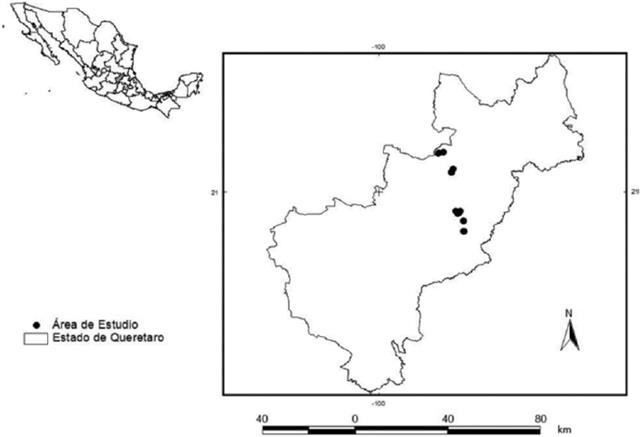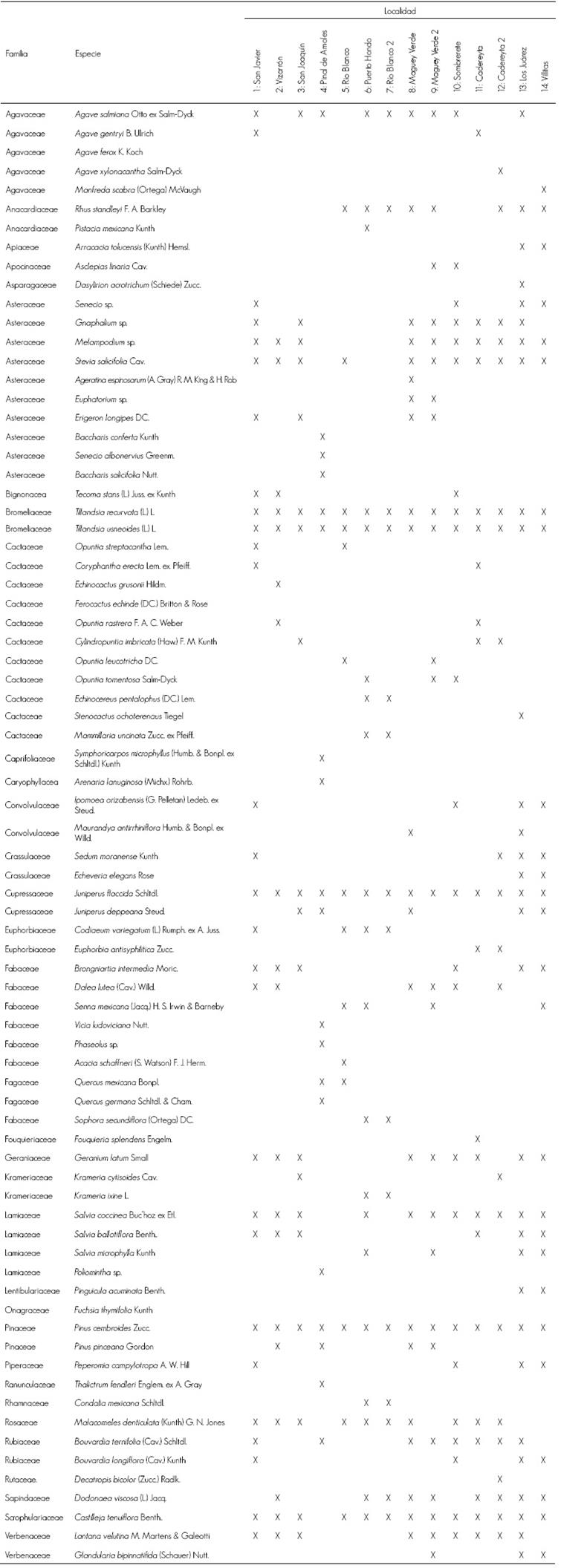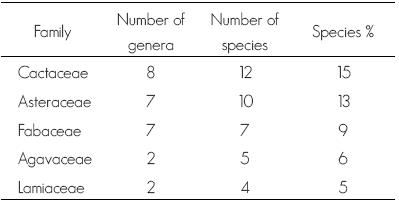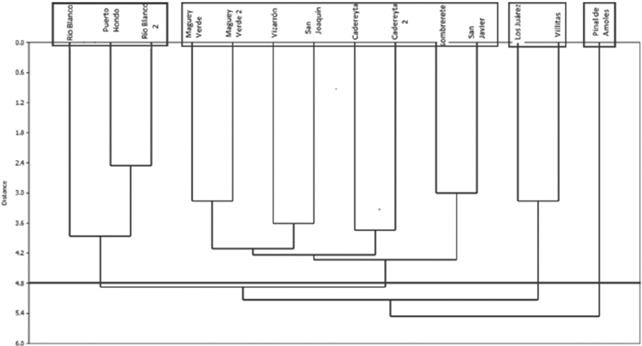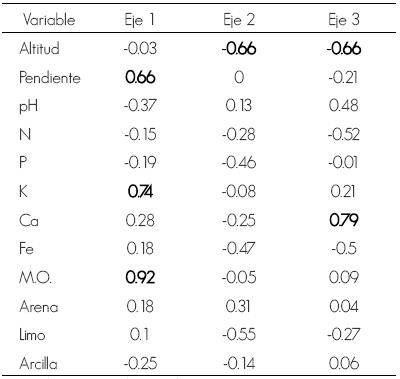Services on Demand
Journal
Article
Indicators
-
 Cited by SciELO
Cited by SciELO -
 Access statistics
Access statistics
Related links
-
 Similars in
SciELO
Similars in
SciELO
Share
Revista mexicana de ciencias forestales
Print version ISSN 2007-1132
Rev. mex. de cienc. forestales vol.7 n.33 México Jan./Feb. 2016
Articles
Classification and ordination of pinyon pine forests of Querétaro State
1División de Ciencias Forestales, Universidad Autónoma Chapingo, México. Correo-e: didorog@latinmail.com
2Departamento de Preparatoria Agrícola, Área de Biología Universidad Autónoma Chapingo, México.
3Posgrado en Hidrociencias. Colegio de Postgraduados Chapingo, México.
The Queretanian desert, particularly that part within the Sierra Gorda, includes an area with the greatest abundance of pinyon pines in Mexico. The study here described was carried out in 14 locations of this kind of forests with the aim to make the structural and floristic characterization as well as to establish a relationship between the structure and the species composition with their physical environment. Seasonal samplings were performed from June 2013 to June 2014 and 2 000 m long walk rounds by location were made; thus annual and perennial herbs, shrubs and trees were collected and identified. Results show the existence of three taxa that belong to this group: P. cembroides, P. cembroides var. bicolor and P. pinceana; which, together with Juniperus flaccida make up four different associations of dominance and codominance, each one with different degrees of floristic similitude, which were defined by a cluster analysis. The ordination by a correspondence canonical analysis suggests that the variables that govern the floristic composition and the ecological groups have a multifactorial origin of variables where the most outstanding which affect their establishment were the organic matter, slope and altitude. Of the three taxa in record in Querétaro State, P. pinceana is the only one considered in the NOM-059 regulation and has been classified as endangered species.
Keywords: Canonical Correspondence Analysis; plant association; plant composition; plant community; forest structure; Pinus cembroides Zucc
El desierto queretano, en especial el que está dentro de la Sierra Gorda, incluye una de las áreas con mayor abundancia de pinos piñoneros en México. El estudio descrito se llevó acabo en 14 localidades de bosques de estas coníferas con el objetivo de caracterizarlos estructural y florísticamente, así como establecer una relación entre la estructura y la composición de especies de las comunidades con su ambiente físico. Se realizaron muestreos estacionales de junio del 2013 a junio del 2014, y recorridos de 2 000 m por localidad, donde se recolectaron e identificaron herbáceas anuales y perennes, arbustos y árboles. Los resultados indican la existencia de tres taxa pertenecientes al grupo de los piñoneros: P. cembroides, P. cembroides var. bicolor y P. pinceana; mismos que junto con Juniperus flaccida forman cuatro diferentes asociaciones de dominancia y codominacia, cada una con distintos grados de similitud florística, los cuales fueron definidos por un análisis de agrupamiento. La ordenación mediante un análisis de correspondencias canónicas sugiere que las variables que rigen la composición de la vegetación y los grupos ecológicos son de origen multifactorial; de ellos, los más relevantes para su establecimiento son la materia orgánica, la pendiente y la altitud. P. pinceana es la única dentro de la NOM-059, de las tres registradas en el estado de Querétaro, y ha sido catalogada como en peligro de extinción.
Palabras clave: Análisis de correspondencias canónicas; asociaciones vegetales; composición florística; comunidad vegetal; estructura forestal; Pinus cembroides Zucc
Introduction
It is estimated that there are 46 species of the Pinus genus in Mexico and from them, pinyon pines produce edible seeds. They are endemic to North America, where they have a broad distribution, from south Idaho (Pinus monophylla Torr. & Frém, 42° 16' N) in the southwest of the United States of America, up to the south of Puebla State in Mexico (Pinus cembroides subsp. orizabensis D. K. Bailey, 18°27' N) and they grow under different climate regimes. They may live in high places as P. edulis Engelm. does in the Rocky Mountains or in warm low lands as P. cembroides Zucc. (Armentrout and Pieper, 1988; Richardson, 1998).
The Queretanian desert, particularly that part within the Sierra Gorda, includes an area with the greatest abundance of pinyon pines in Mexico. Mainly, two species coexist at the central part, Pinus cembroides and Pinus pinceana Gordon. In addition, Zavala and Campos (1993) recorded an important population of P. cembroides var. bicolor Little in Cadereyta Municipality.
Pinyon pines are very relevant species for the arid zones of the country, since sometimes they are the only forest resource there. From this species, the locals get firewood or building material, as well as nourishment and economic profit from the seed, to which it must be added the fact that such natural communities provide a several environmental services (Villarreal et al., 2009). On the other hand, these pines are acknowledged for their great adaptability and resistance to adverse conditions, which confers them a status of great potential for ecological restauration (Ríos et al., 2008).
The communities dominated by pinyon pines in the tree stratum have, in general, a transitional place between the mild-weather forests of the mountain areas and the xerophytic scrubland, from which the result is a mixed floral composition (Granados et al., 2012; Granados et al., 2015). In addition to the complex relationships established between them, the species interchange of two different floras provide a unique physiognomy to this kind of forests.
The different species of plants that make up a particular ecosystem have very different tree dimensions (height, cover and diameter) and regularly are in specific sites as a response to changes in climate factors, environmental gradients or to disturb, being natural or from human origin (Remmert, 1991).
Classification is a widely used method to identify the associations in the floristic composition of the communities and therefore, to distinguish in a more precise and synthetic way the different ecological associations of vegetation; ordination, on the other side, is a complementary method by which the influence of the environmental or edaphic factors upon the presence and dynamics of some groups is determined (Sánchez and López, 2003; Alcaraz, 2013; Granados et al., 2015).
Harris et al. (2003) mentioned the importance of using multivariate techniques in synecological studies as a mechanism to detect the environmental factors responsible of the changes in the structure and distribution of vegetation. Although there are several works that have made a contribution to the biological and ecological knowledge of the pinyon forests in other regions, this kind of study, is convenient as the understanding of the structure of the vegetal communities favors a right decision taking in terms of use and conservation.
The aims of this work were to describe the physiognomy and flora of the vegetation in the pinyon pine forests of Querétaro State, as well as to establish a relation between the structure and composition of the communities with their physical environment.
Materials and Methods
Study area
The study area is located in the arid region of Querétaro State and its surrounding mountain system that, as a whole, is known as Sierra Gorda. This zone is part of the physiographic province of the Sierra Madre Oriental, at an altitude of 2 000 to 2 900 m. The semi-warm semi- humid weather prevails, which includes Arroyo Seco, Jalpan de Serra, Pinal de Amoles and Landa de Matamoros Municipalities; and to the southwest, the weather is dry and semi-warm with summer rains (Conagua, 2002).
Field work was performed in the following 14 locations of pinyon pine forests: Cadereyta 1 and 2, Los Juárez, Maguey Verde 1 and 2, Pinal de Amoles, Puerto Hondo, Río Blanco 1 and 2, San Javier, San Joaquín, Sombrerete, Villitas and Vizarrón (Figure 1).
Floristic composition
Seasonal samplings were performed from June 2013 to June 2014, as well as 2 000 m long walk rounds by location were made and, thus, annual and perennial herbs, shrubs and trees were collected and identified. The specimens that were not identified in situ were collected and processed for that purpose in the herbarium of the División de Ciencias Forestales and of the Preparatoria Agrícola of the Universidad Autónoma Chapingo.
Description of vegetation
The structural analysis was based on the physiognomical characterization of each location, in which 12 points selected at random were taken at a distance of 20 m at least between them. In each point was applied the central quadrant point technique (Cottam and Curtis, 1956), in which species with a tree life form with a BHD over 10 cm were taken as a reference; in each site two parallel perpendicular lines that form quadrants were drawn, and in each of them the distance to the closest tree to the central point were measured, and the name of the species, height and BHD were recorded.
This variables allowed to make an estimation of the frequency, dominance and density values of the more representative species in each location and were calculated as follows:
The mean basal area is the average of the basal area of all the members of each species; it was calculated with the following formula:
Density was defined as the total number of individuals of all species in 100 m2 and was determined as follows:
Mean distance is the average of all de distances among the individuals of the species recorded in regard to the central point.
The relative values of frequency, density and dominance were combines in the Relative Importance Value (VIR, for its Spanish acronym) based upon de formula by Müeller-Dombois and Ellenberg (1974):
With the Relative Importance Values of the species for each locality, the graphical representation of the vertical and horizontal structure of communities through physiognomic type semi-realistic dimensional profiles was performed according to the method of Richards (1952). Schemes called danserograms were also developed, which are aimed to facilitate understanding of the organization of plant communities, their classification and selection of methods for their systematic study (Granados and Tapia, 1990). The symbols used in these graphics to describe the most representative characteristics of each species are illustrated in Figure 2.
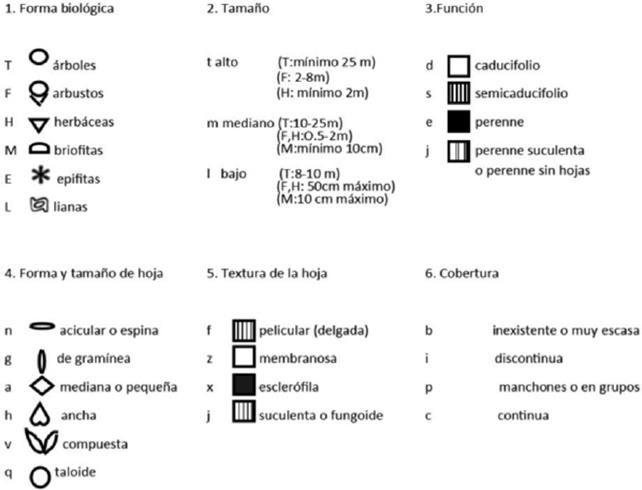
Figure 2 Symbols for the structural description of the community proposed by Dansereau, 1957 (Adapted by Valenzuela and Granados, 2009).
Classification and Ordination
About the environmental variables, in each site the exposition, slope and altitude of each community were noted. In the case of the edaphic variables, it was necessary to take a 1 kg of soil samples from each site with pinyon pine forest for their subsequent analysis at the Laboratorio Central Universitario of the Departamento de Suelos of the Universidad Autónoma Chapingo, where the following was determined:
pH, by a potentiometer with a 1:2 soil-water ratio.
N (Nitrogen), extracted by a 2N potassium chloride concentration and was determined by steam stripping.
P (Phosphorous), obtained by the Bray P-1 (Bray and Kurtz, 1945) and Olsen (Olsen and Sommers, 1982) extraction methods.
K (Potasium), extracted in ammonium acetate at a 1N concentration, pH 7 in a 1:20 ratio and was quantified by flame emission spectrophotometry.
Ca (Calcium) extracted in ammonium acetate at a 1N concentration, pH 7 in a 1:20 ratio and was determined by atomic absorption spectrophotometry.
Fe (Iron), extracted with DTPA in a 1:4 ratio and was determined by atomic absorption spectrophotometry.
Organic matter (MO) by the Walkley and Black method (1934).
Soil texture, by a Bouyoucos hydrometer.
Vegetation was classified by a cluster or grouping analysis, from which a general area dendrogram came, with binary properties (presence-absence) of the species present at each one of the localities. The Bray-Curtis similitude index was used a distance measure and as a link algorithm of the average among groups at a cut level of 0.5. The analysis were made with the calculation PAST 3.01 program (Hamer et al., 2001)
Later, a Canonical Correspondence Analysis (ACC, for its acronym in Spanish), with a direct ordination, in which the species composition is directly related with the environmental variable gradient (Sánchez and López, 2003). Species, sites and the environmental variables taken at each locality were the components correlated with ACC. The calculation program that was used was CANOCO (Ter Braak and Smilauer, 1998).
Results
Floristic composition
A total of 78 species of vascular plants in the pinyon pine forests of Querétaro State were identified, which belong to 63 genera and 39 families (Table 1).
Cactaceae followed by Asteraceae were the families with a greater number of species (Table 2).
Classification
From the composition of species in each site, a dendrogram with the cluster analysis was obtained; with a cutoff level of 4.8, four different groups corresponding to four different floristic associations (Figure 3) were recorded; the Pinus cembroides forest -Juniperus flaccida Schltdl., dominated at the canopy by the Pinus cembroides forest, sometimes accompanied by Pinus pinceana, Pinus cembroides-Pinus cembroides var. bicolor forest and forest dominated by Juniperus flaccida accompanied by Pinus cembroides.
The structure and general physiognomy of each one of the vegetal associations is described as follows.
Pinus cembroides-Juniperus flaccida forest. This vegetal association is dominated at the canopy by Pinus cembroides and Juniperus flaccida, of which the first species is the most common, most abundant and dominant by basal area; includes few companions arboreal individuals, such as Rhus standleyi F. A. Barkley and Acacia schaffneri (S. Watson) F. J. Herm. (Figure 4).
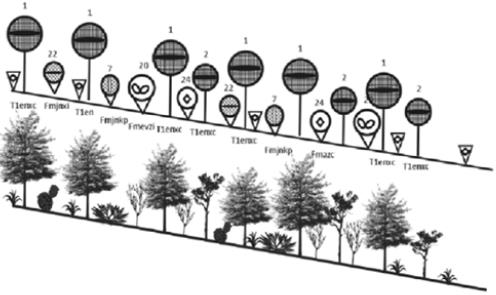
Figure 4 Danserogram and physiognomical profile of the Pinus cembroides Zucc.-Juniperus flaccida Schltdl. forest. 1. Pinus cembroides Zucc., 2. Juniperus flaccida Schltdl., 7. Agave salmiana Otto ex Salm-Dyck, 20. Rhus standleyi F. A. Barkley, 22. Opuntia tomentosa Salm-Dyck, 24. Dodonaea viscosa (L.) Jacq.
The vertical and horizontal structure may be observed in the physiognomical profile and the danserogram of Figures 4 and 6; the upper stratum is made up by P. cembroides and J. flaccida, with a height of 7 to 1 m and an open cover; the middle stratum, from 3 to 6 m high, gathers, mainly, individuals of Acacia schaffneri and young pinyon pine trees. The shrub stratum is made up by Agave salmiana Otto ex Salm-Dyck, Echinocereus pentalophus (DC.) Lem., Mammilaria uncinata Zucc. ex Pfeiff., Croton incanus Kunth, Dodonaea viscosa (L.) Jacq., while in the herb stratus, can be found Senna mexicana (Jacq.) H. S. Irwin & Barneby, Krameria ixine L., Condalia mexicana Schltdl., Amelanchier denticulata (Kunth) K. Koch and Castilleja tenuifolia Benth., as the most important species.
This association was recorded in three localities, Río Blanco 1 y 2 and Puerto Hondo, all with a semidry warm climate and soils of the Calcareous castañozem type. The prevailing exposition of these sites is W, with average slopes of 35 %. The least altitude in all forests for these associations is 2 01 - 2 071 m, which favors the high representation of the xerophyllic elements.
Pinus cembroides and P. cembroides-Pinus pinceana forests. This association is characterized by the total dominance of Pinus cembroides in the tree layer or even codominant with Pinus pinceana, but in both cases the floristic composition has great similarity, and that is why they form a single floristic group. Some of the accompanying tree species in these communities are J. flaccida, J. deppeana Steud. and R. standleyi.
Eight localities share similarity in species composition: San Joaquín, Cadereyta 1 and 2, Sombrerete, San Javier, where P. cembroides is dominant and Vizarrón, Maguey Verde 1 and 2 in codominance with Pinus pinceana. The latter sites have steep slopes (~ 42 %), with NW and W expositions. The altitudinal range of these communities is 2 070-2 820 m, with a predominant temperate subhumid climate.
P. cembroides and P. pinceana dominate the canopy in the upper layer with a height of 8 to 1 m and the lower layer of 4 to 7 m is represented mainly by Juniperus flaccida and J. deppeana (Figure 5).
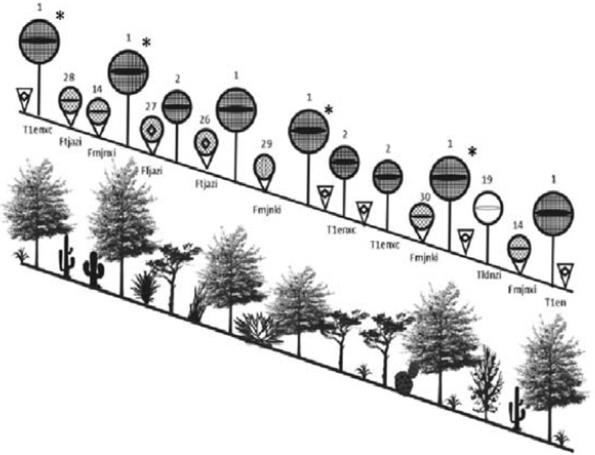
Figure 5 Danserogram and physiognomical profile of the Pinus cemborides Zucc. forest. 1. Pinus cembroides Zucc., 2. Juniperus flaccida Schltdl., 14. Cylindropuntia imbricata (Haw.) F. M. Kunth, 19. Acacia schaffneri (S. Watson) F. J. Herm., 26. Fouquieria splendens Engelm., 27. Euphorbia antisyphilitica Zucc., 28. Coryphanta erecta (Lem. ex Pfeiff.) Lem., 29. Agave gentryi B. Ullrich, 30. Opuntia cantabrigiensis Lynch.
The herbaceous layer is made up by Castilleja tenuifolia, Stevia salicifolia Cav., Geranium latum Small, Melampodium sp., Dalea lutea (Cav.) Willd., Echinocactus grusonii Hilm. and Opuntia rastrera F.A.C. Weber; the associated shrubby flora consists mainly of Lantana velutina M. Martens & Galeotti, Dodonea viscosa, Amelanchier denticulata, Tecoma stans (L.) Juss. ex Kunth, Brongniartia intermedia Moric. and Salvia ballotiflora Benth. In addition, epiphytic Tillandsia recurvata and T. usneoides are plentiful.
Pinus cembroides - P. cembroides var. bicolor forest. Los Juárez and Villitas have this kind of vegetal association, both in which the taxa with highest RIV were P. cembroides and P. cembroides var. bicolor, as they are the most frequent species with the highest density; however, the first one has the greatest average basal area (Figure 6).
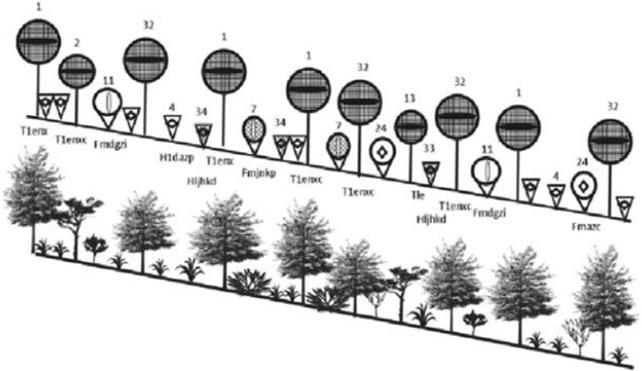
Figure 6 Danserogram and physiognomical semi-realistic profile of the proper vegetation of group 3. 1. Pinus cembroides Zucc., 2. Juniperus flaccida Schltdl., 4. Bouvardia longiflora, 7. Agave salmiana, 1. Stevia saliciflora, 13. Juniperus deppeana, 24. Dodonaea viscosa, 32. Pinus cemboides var. discolor, 34. Pinguicola acuminata
The highest level of the canopy is rather low and is 7.5 m tall and in it the co-dominant species coexist with Juniperus flaccida and Juniperus deppeana. The shrub stratum is made up of Gnaphalium sp., Lantana velutina, Dodonea viscosa, Bouvardia ternifolia, Agave salmiana, Dasylirion acrotrichum (Schiede) Zucc. and Pinguicula acuminata Benth.
This ecological group develops in the higher parts in record, from 2 850 to 2 890 masl with a mean slope of 40 %, a S exposition and a sub-humid mild-weather, mainly.
Juniperus flaccida - Pinus cembroides forest. The last association in record is dominated at the canopy by Juniperus flaccida and Pinus cembroides; the first one being a more frequent taxon, with greatest density and basal area, that is, the most important species for the ecosystem. Such association was found just in one location, Pinal de Amoles, and was the richest community in species composition of the tree stratum, with related species such as Quercus germana Schltdl. & Cham., J. deppeana, P. pinceana and Q. mexicana Bonpl.
The tree stratum gets up to 1 m high, in which P. cembroides is the most outstanding species. The shrub layer includes Baccharis conferta Kunth, Bouvardia ternifolia, Baccharis salicifolia (Ruiz & Pav.) Pers., Fuchia thymifolia Kunth, Scenecio albonervius Greenm., Symphoricarpos microphyllus HBK and Agave salamiana. The most relevant herbs that were identified were Thalictrum fendleri Engelm. ex A. Gray, Arenaria lanuginosa (Michx.) Rohrb. and Vicia ludoviciana Nutt. (Figure 7).
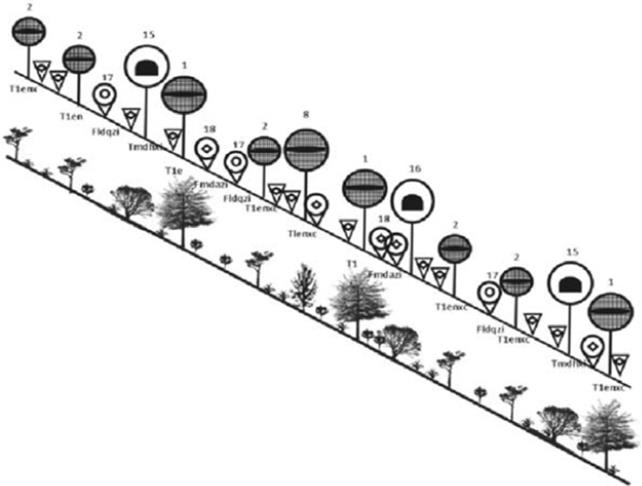
Figure 7 Danserogram and physiognomical semi-realistic profile of the vegetation of the site in Pinal de Amoles. . Pinus cembroides, 2. Juniperus flaccida Schltdl, 8. Pinus pinceana Gordon, 15. Quercus germana Schltdl. & Cham., 16. Quercus mexicana Bonpl., 17. Senecio sp., 18. Baccharis conferta Kunth.
This locality shows a greater affinity with the species of mild-weather forest, which become evident in its high tree diversity; it grows in steep slopes (73 %), at 2 427 masl with a prevailing side slope towards NW and a mild-subhumid weather with summer rains.
Ordination
Some of the most relevant physical factors for the establishment of the communities were used to manage the pinyon pine forests from a canonical correspondence analysis, which detects the correlation between the environmental variables and the composition of each of the locations. The statistical values for the three first ordination axis are shown in Table 2, which suggests that the environmental factors that were analyzed are correlated with the flora associated to the pinyon forests of Querétaro and that these three axes may explain 60 % of the variation in the localities.
In regard to the most relevant environmental variables for the ordination of data (Table 3) it may be noted that as altitude becomes higher, pH descends while iron increases; on the other hand, the increment in the amount of organic matter means the same for the potassium and calcium concentrations, both essential macronutrients for the nourishment of plants.
Table 3 Correlation matrix between the environmental variables that were assessed in the actual study.
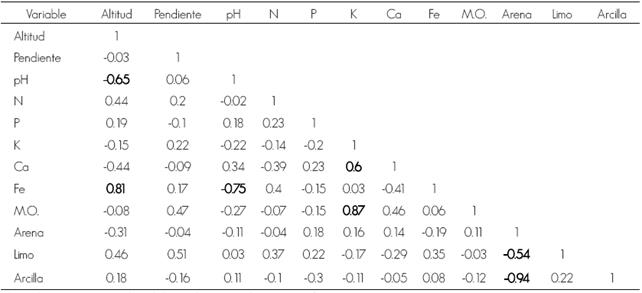
The correlations with significant values are in bold.
The most important variables that define the differential establishment of species in the pinyon pine communities of Querétaro are the organic matter, potassium, calcium, altitude and slope (Table 3).
The behavior of the locations, and therefore, of the vegetal associations, according to the environmental variables, may be observed in Figure 8, in which three clusters can be seen, in one of which two different associations are together: Pinus cembroides and P. cembroides and P. cembroides var. bicolor.
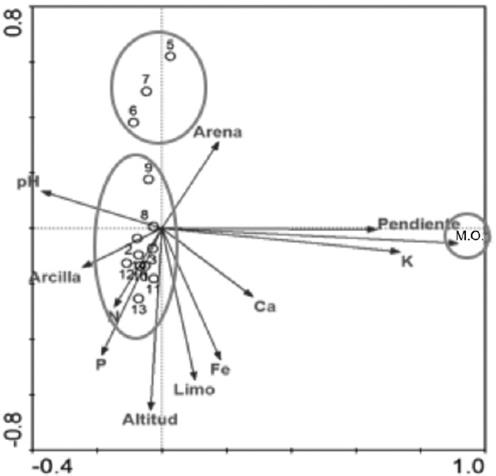
Figure 8 Canonical correspondence analysis of 14 sampling sites with 78 plant species and 12 environmental variables.
Discussion
Pinyon pine forests are very particular plant communities, which form a true ecotone between xerophyllic and temperate vegetation, and endow these forests a unique physiognomy, ecologically complex and highly vulnerable (Granados et al., 2015). The constant pressure on these ecosystems alter their components, which affects their natural regeneration (Fernández, 1997).
The high biodiversity and vulnerability of forests of pinyon pine turns them into focal points to implement management plans and sustainable use, as well as regeneration and specifically, conservation programs (Myers et al., 2000).
The first step for the latter is to make an inventory of biodiversity. In this study a flora list of 78 species was made, which suggests that if the habitat of the pinyon pines of Querétaro is conserved, such species would act as umbrella (Bifolchi and Lodé, 2005), they would extend their protection to more than 77 species of plants, without including the non- vascular, fungi, bacteriae and animals associated to these ecosystems, that as ecotones, would promote the preservation of several biomes.
Cactaceae was the best represented family in this study; Reynolds (2005) stated that disturbed environments gather a greater number of species with affinity to xerophyllic climates, and therefore, those related to mild-weather climate are reduced. The xerophytic dominance of xerophytes is an indicator of an inefficient conservation condition in which the pinyon pine forests of Querétaro are (Romero et al., 2012).
The different associations of dominance at the canopy and the floral composition of each one of them is the result of a multifactorial interaction, in which the most influential variables are the organic matter and their linked elements (potassium and calcium), slope and altitude.
The locality with the highest concentration of organic matter in the soil was the richest in tree species, besides being the most differentiated floristically. The higher affinity of Pinal de Amoles to the temperate vegetation has favored the inclusion of species with laminated leaves such as oaks, which contributes to increase litter and therefore organic matter, which favors that soils become richer in nutrients. However in this location, Juniperus flaccida recorded higher value of importance than P. cembroides, a condition that could be due because pinyon pines and especially this conifer, reach their adaptive optimal to grow on poor, stony, calcareous soils with a high content of gypsum, thin and well drained (Granados et al., 2015). J. flaccida is more responsive to environmental changes (Himmelsbach et al., 2008) and their populations benefit from disturbance, mainly those of anthropogenic origin (Ayerde and López, 2006).
On the other hand the most widespread associations within the state of Querétaro were the forests dominated by Pinus cembroides or in codominance with P. pinceana, present in eight locations where most of which had a southern exposition, which determines a drier environment (Romero and García 2002; Luna et al., 2008).
Both associations have a great floristic similarity, so conglomerate in one group, because its climate and soil regimes are very similar, but the existence of one or another association is dependent on the topography. Río et al. (2008) reported that P. pinceana does best in steep slopes and is common to grow within the creeks, as confirmed in this investigation.
The factor that defines the presence of communities codominated by P. cembroides and P. cembroides var. bicolor is altitude, as they developed in the localities of greater height 2 853-2 882 m, which is directly related to precipitation and temperature (Xianping et al., 2006). Romero et al. (2012) mention that P. cembroides var. bicolor establishes a close relationship with temperate environments, which explains their distribution in higher altitude sites.
Nine species of pinyon pine trees are classified within a risk category; of the three taxa registered in the state of Querétaro, P. pinceana is the only one within the NOM-059 (Semarnat, 2010), classified as endangered. In the study area it has a wide distribution and coverage that is limited to steep creeks and difficult to access, which has kept these populations away from human activities such as agriculture, grazing and seed collecting. This situation allows to observe the relevance of these locations as priority sites for conservation of endangered species and species with potential use and sustainable management.
Conclusions
Pinyon pines are species of a great environmental scope and have a great resistance to adverse conditions such as droughts, frosts and poor soil, but in spite of these attributes, human activities such as grazing, agriculture, wood harvest and mainly the collection of their edible seeds are reducing their numbers. Therefore, to take actions focused on their conservation is a priority.
The results shown here are the foundation to make management plans that may help to protect the biodiversity of these forests, since form the floristic composition and the structural analysis, the payment for environmental services may be promoted and thus, to mitigate the pressure over the pinyon trees, which many times are the only resources of financial resources for some people. On the other hand, the ordination according to the physical and edaphic gradients is useful to know the most convenient sites for the reforestation of each species, as well as for their cultivation at the nursery.
Finally, to favor the use of pinyon pines as umbrella species in order to preserve at least three different biomes (xerophyllic scrubland, pinyon pine forest and mild-weather forest) seems to be a viable short-cut to increase the scope of their protection in a short time.
Conflict of interests
The authors declare no conflict of interests.
Contribution by author
Field work as well as the identification of species was accomplished by all the authors. Marcela Rosas Chavoya: physiognomical analysis, building of data bases and writing of the first manuscript; Diódoro Granados Sánchez: responsible of the project, writing and review of the manuscript and implementation of the arbitral observations to the document; Ro Linx Granados Victorino: statistical analysis, writing of the manuscript and implementation of the arbitral and editorial observations to the document; Salvador Esparza Govea: making of the semi-realistic profiles and daserograms of the physiognomy of vegetation.
Acknowledgements
The authors would like to thank the personnel of the División de Ciencias Forestales of the Universidad Autónoma Chapingo for having conferred the conditions, resources and space to accomplish the actual project, as well as to the reviewers of the manuscript for their correct observations.
REFERENCES
Alcaraz A., F. J. 2013. Formas vitales, estratificación y fenología. Universidad de Murcia. Murcia, España. 20 p. [ Links ]
Armentrout, S. M. and R. D. Pieper. (1988). Plant distribution surrounding Rocky Mountain pinyon pine and one seed jumper in south-central New Mexico. Journal of Range Management Archives 41:139-143. [ Links ]
Ayerde L., D. y L. López M. 2006. Estructura poblacional y parámetros demográficos de Juniperus flaccida Schltdl. Madera y Bosques 12(2): 65-76. [ Links ]
Bifolchi, A. and T. Lodé. 2005. Efficiency of conservation shortcuts: an investigation with otters as umbrella species. Biological Conservation 126(4): 523-527. [ Links ]
Bray, R.H. and L. T. Kurtz. 1945. Determination of total, organic and available forms of phosphorus in soils. Soil Science 59: 39-45. [ Links ]
Comisión Nacional del Agua (Conagua). 2000. Servicio Meteorológico Nacional. http://smn.cna.gob.mx/index.php?option=com_content&view=article &id=42&Itemid=75 (8 de septiembre de 2014). [ Links ]
Cottam, G. and J. Curtis. 1956. The use of distance measures in phytosociological sampling. Ecology 32 (2): 172-229. [ Links ]
Fernández N., R. 1997. Notas sobre la vegetación y flora del municipio de San Joaquín Querétaro, México. Polibotánica 4: 10-36. [ Links ]
Granados V., R. L., D. Granados S. y A. Sánchez G. 2015. Caracterización y ordenación de los bosques de pino piñonero (Pinus cembroides subsp. orizabensis) de la Cuenca Oriental (Puebla, Tlaxcala y Veracruz). Madera y Bosques 21(2): 23-43. [ Links ]
Granados, D., M. A. Hernández y G. López. 2012. Ecología de los desiertos del mundo. Universidad Autónoma Chapingo. Texcoco, Edo. de Méx., México. 503 p. [ Links ]
Granados, S. y V. Tapia. 1990. Métodos de estudio de la vegetación. Chapingo, Estado de México: Universidad Autónoma Chapingo. Texcoco, Edo. de Mexico, Mexico. 235 p. [ Links ]
Hamer, Ø., D. Harper and P. Ryan. 2001. PAST: Paleontological Statistics Software Package for Education and Data Analysis. Paleontología Electrónica 4: 1-9. [ Links ]
Harris, T. A., G. P. Asner and M. E. Miller. 2003. Changes in vegetation structure after long-term grazing in Pinyon-Juniper Ecosystems: integrating imaging spectroscopy and field studies. Ecosystems 6: 368-383. [ Links ]
Himmelsbach W., E., E. Treviño, H. González and T. González. 2008. Drought resistance of mixed pine-oak forest species in the Sierra Madre Oriental, México. Tropentag 7: 1-4 [ Links ]
Luna C., M., A. Romero M. y E. García M. 2008. Afinidades en la flora genérica de piñonares del norte y centro de México análisis genético. Revista Mexicana de Biodiversidad 79: 449-458. [ Links ]
Müeller-Dombois, D. and H. Ellenberg. 1974. Aims and methods of vegetation ecology. John Wiley and Sons, Co. New York, NY, USA. 547 p. [ Links ]
Myers, N., R. A. Mittermeier, C. G. Mittermeier, G. A. Da Fonseca and J. Kent. 2000. Biodiversity hotspots for conservation priorities. Nature 403(6772): 853-858. [ Links ]
Olsen, S. R. and L. E. Sommers. 1982. Phosphorus. : Page, A. L .I (ed.). Methods of soil analysis, Part 2, Agronomical Monographs 9. Madison, WI, USA. pp. 403-430. [ Links ]
Remmert, H. 1991. The mosaic-cycle concept of ecosystems. Springer-Verlag. Berlin, Germany. 21 p. [ Links ]
Reynolds, J. 2005. Aspectos socioeconómicos y biofísicos de la desertificación. Ecosistemas 14(3): 3-21. [ Links ]
Richards, P. W. 1952. The tropical rain forest, an ecological study. Cambridge University Press. Cambridge, UK. 450 p. [ Links ]
Richardson, D. 1998. Ecology and biogeography of PinusCambridge University Press. Cambridge, UK. 527 p. [ Links ]
Ríos, E., R. Hoogh y J. Navar. 2008. Ensayo de especies con pinos piñoneros en el nordeste de México. Revista Chapingo, Serie: Ciencias Forestales y del Ambiente 14(2): 97-104. [ Links ]
Romero M., A. y E. García M. 2002. Estabilidad y elasticidad de la composición florística de los piñonares de San Luis Potosí, México. Agrociencia 36(2): 242-254. [ Links ]
Romero M., A. , J. L. Flores F., M. Luna C. and E. García M. 2012. Effect of slope and aspect on the associated flora of pinyon pines in central Mexico. The Southwestern Naturalist 57(4): 452-456. [ Links ]
Sánchez G., A. y L. López M. 2003. Clasificación y ordenación de la vegetación del norte de la Sierra Nevada, a lo largo de un gradiente altitudinal. Anales del Instituto de Biología, Serie: Botánica. 74(1): 47-71. [ Links ]
Secretaría del Medio Ambiente y Recursos Naturales (Semarnat). 2010. Norma Oficial Mexicana NOM-059-SEMARNAT-2010, Protección ambiental. - Especies nativas de México de flora y fauna silvestres - Categorías de riesgo y especificaciones para su inclusión, exclusión o cambio - Lista de especies en riesgo. Diario Oficial de la Federación. Secretaría de Gobernación. México, D. F., México. http://dof.gob.mx/nota_detalle.php?codigo=5173091&fec ha=30/12/2010 (6 de noviembre, 2014) [ Links ]
Ter Braak, C. and P. Smilauer. 1998. CANOCO reference manual and user ́s guide to CANOCO for Windows: software for canonical community ordination (v.4). Microcomputer Power. New York, NY, USA. 500 p. [ Links ]
Valenzuela, N. y S. D. Granados. 2009. Caracterización fisonómica y ordenación de la vegetación en el área de influencia de El Salto, Durango, México. Revista Chapingo. Serie: Ciencias Forestales y del Ambiente 15(1): 29-41. [ Links ]
Villarreal Q., J. A., O Mares A., E. Cornejo O. y M. A. Capó. 2009. Estudio florístico de los piñonares de Pinus pinceana Gordon. Acta Botánica Mexicana (89): 97-124. [ Links ]
Walkley, A. and I. Black. 1934. An examination of the Degtjareff method for determining soil organic matter and a proposed modification of the chromic acid titration method. Soil Science 37: 29-38. [ Links ]
Xianping, Z., W., Mengben, S. Bo and X. Yang. 2006. Quantitative classification and ordination of forest communities in Pangquangou Nacional Nature Reserve. English edition of the Chinese Language Journal 26(3): 754-761. [ Links ]
Zavala C., F. and J. L. Campos. 1993. Una nueva localidad de Pinus discolor Bailey y Hawksworth en el centro de México. Acta Botánica Mexicana (25): 21-25. [ Links ]
Received: January 27, 2015; Accepted: December 21, 2015











 text in
text in 

